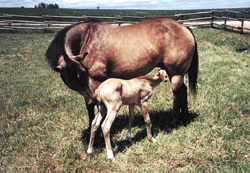The next step - an exam by veterinarian Ted Vlahos to ensure Suzie had no low-grade uterine infection. All was well. She
was bred over the Fourth of July and her ultrasound confirmed success.

Suzie had a problem-free pregnancy. We vaccinated her for rhinopneumonitis in the fifth, seventh and ninth months. She received a full barrage of vaccinations (Eastern and Western encephalitis, tetanus, flu/rhino and rabies) in her tenth month so she could pass the antibodies on to her foal. Although I quit riding in the seventh month, I spent plenty of time with her.
As the due date approached, Dr. Vlahos recommended using FoalWatch, which tests mares' milk for a surge in calcium levels.
"We've found this calcium test to be the most accurate prediction of when the mare is going to foal, accurate to within a few hours. A rise in calcium shows a fetal readiness for birth," Vlahos explains. "You know your mare's due date, you know by the discharge of milk from the udder and the loosening of the rump muscles that your mare is close to foaling. That's when you start doing the calcium check."
The evening before she foaled, I had done a calcium check. The level was beginning to rise. The next morning, my boarding stable owner called to say Suzie was leaking milk and he was taking her in to the clinic. (I had opted to foal her out at my veterinarian's clinic since I didn't have my own place. I was leery about a first foal at age 15.)
"The calcium count has risen rapidly," the vet told me when I arrived. "You'll have a foal by late afternoon." Actually, she gave birth within the next hour. I watched as she began pacing, lying down and getting up. Only a few minutes later, a white sac appeared, then a hoof.
"Once your mare reaches stage two of labor - the water breaks - it's a quick progression. You should see the white sack, then a hoof, another hoof and the nose within 20 minutes. A healthy foal should be out in 45 minutes," the Sheridan, Wyo. vet explained. "The horse's placenta separates very quickly from the uterus once the birth begins. If the foal isn't born promptly, it will suffocate."
If the natural progression doesn't start shortly after the water breaks, call your veterinarian immediately, he strongly advises.
I needn't have worried. Suzie lay down. Next came the head, still encased in the sac. Dr. Vlahos stepped over and broke it, allowing the foal to breathe. I saw Pocomaki for the first time, wet, eyes blinking at the startling brightness. Another push, out came the hips, and finally the hind legs. The process had taken less than half an hour. Suzie stood up, broke the umbilical cord, and went down again. She was lying very still, staring.
My vet explained that endorphins released during birth cause some horses to be out of it for a few minutes. I always thought the mare rose immediately to check out her new baby. Not so, at least in this case - which was good for my imprinting intentions.
The night before, I had pored over Robert Miller's book, Imprint Training of the Newborn Foal. At the okay from Dr. Vlahos, I leapt into action, crouching beside my new little friend.
I followed Miller's imprinting techniques closely. I rubbed the foal's head and ears over and over. I put my fingers in each ear and each nostril 50 times to desensitize the areas. I massaged his upper lips and put my fingers in his mouth. I tapped on the bottom of each tiny hoof 50 times. (This was after I looked in horror at the feathery-looking substance on the bottom of the hooves. Normal? Yes, the vet assured me, every newborn has soft fetal hooves. This prevents the mare from being injured during the foal's passage through the birth canal. The protection wears off within a couple of days.)
While I was busy imprinting, the foal had his navel stump dipped in a nolvasan solution and received a tetanus antitoxin vaccine.
After 10 minutes, Suzie stood but ignored him. I became worried she would step on him or abandon him. She turned around a few times in the stall, finally came nose to nose and began licking him. They bonded.
Poco decided it was time to rise and shine. After a few attempts to get his balance, he was finally standing, wobbling. Suzie was nuzzling and nickering as he attempted to get the long legs moving. He tried nursing between her front legs and walked underneath her a couple of times. After five minutes of fruitless searching, he found the udder and received his first colostrum. He was nursing within an hour of being born.
My advice for those who plan to breed their mare: Work closely with your veterinarian from pre-conception through foaling, imprint and enjoy the miracle.
| Imprint impressions
Does imprinting the newborn cause a disturbance in mare/foal bonding? No, says veterinarian Robert Miller. In fact, quite the opposite.
"A majority of foal-rejection cases occur because the mare is afraid of the foal," notes Miller in his book, Imprint Training of the Newborn Foal. He explains that many mares haven't seen a foal until they have one, and are afraid. "However, I believe when a mare looks around and sees a familiar human restraining and manipulating the foal, it reassures her," he says.
Another benefit? Miller says mares with imprint-trained foals tend to be less aggressive towards humans interacting with their foals, even from day one. |

|